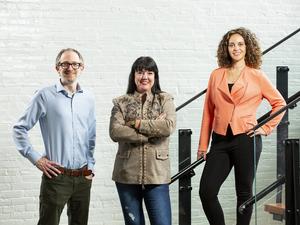
Those who feel burned out at work are more likely to experience adverse physical health effects, a new study from researchers at the University of Louisville found.
Since the onset of the Covid-19 pandemic, topics of burnout, work-life balance, quiet quitting and the Great Resignation have been top of mind for business leaders and employees. But the topic of burnout and its impact on physical health have been part of Brad Shuck and Rachel Keith’s research long before the pandemic.
The research team’s study, which is believed to be the first to link biodata to workplace health risk, comes out of the Christina Lee Brown Envirome Institute at UofL. It connected biomarkers for chronic disease risk to factors such as stress, employee capacity for work assigned, workplace physical and social environment and whether work is regarded as meaningful to the person performing it.
The researchers determined “work determinants of health” to track this. They compared survey results with biological samples that measure hormones signaling sympathetic nervous system activity.
The results showed participants who reported greater well-being, engagement and positive feelings toward their work environment had lower levels of these stress-associated hormones, while the opposite was true for participants reporting poor well-being, isolation and negative feelings toward work, according to a news release on the research.
But a topic as broad as “culture” can sometimes be hard to define, Shuck, a lead researcher and co-founder of Louisville startup OrgVitals, said in an interview with Business First. (OrgVitals is a company which works with consultant groups across the country to help organizations figure out how to better care for their employees through culture data that offer actionable insights.)
Shuck said the study measured culture in terms of workplace community/belonging, workplace isolation, employee engagement and overall organizational culture.
The research showed that if employees were engaged and felt they interacted with work in a positive way, their body responded positively, and if they didn’t, it responded negatively.
“That negative way can have long-term repercussions over time,” said Keith, one of the research leaders. “So if that continues for years and years, and isn't just an isolated thing that your body's dealing with, that can lead to chronic diseases.”
Through this research, Shuck said he was struck by the magnitude of the relationship between workplace culture and physical health. When the research began, he expected to find something, but didn’t expect it to be as large and influential as it was. Work is a very specific experience, Shuck said, that impacts bodies physiologically and biologically.
Keith, who is an associate professor of medicine at UofL and an APRN, said everyone understands that there are workplace stressors, but as a clinician, when she sees patients about heart disease or diabetes, they list things like diet and exercise, but don’t site the impact of stress in their lives.
“More than once I've heard people say, ‘I've done everything, right, how did I end up here?’” Keith said. “Maybe we need to look at more things than just what the individual themselves does to affect their health. Like how other things play a role, either supporting or taking away from, those individual choices?"
Keith said chronic diseases take about 10 years to develop. Linking workplace issues to levels of health risks sooner rather than later is important so individuals can make a change before experiencing a large health issue like a heart attack.
Red flags that show a negative company culture
When people don’t feel that they’re included within the company’s culture, this serves as a red flag for these negative health impacts.
“What's interesting about this is, I think for decades – three decades — employee engagement has been the gold standard. Everybody wants more engagement,” Shuck said. “It's the thing that everybody's after, they just want the number, and everybody wants more of it. What our research shows is that engagement is absolutely one outcome of a great culture. It drives health, but that overall culture, and the ways in which we measure that have changed. We need to begin to pay attention to that.”
Another red flag Shuck cited is dysfunctional leaders in a workplace. He used the term “quiet firing,” which he defined as a passive leader that makes an employee so frustrated and miserable that they quit their jobs.
Some groups are impacted more than others
Charley Miller, co-founder and co-CEO of OrgVitals, said one of the most striking things in the research is the difference between male and female respondents.
It impacts both men and women, but it impacts women more, which leads to more chronic health problems for them.
Miller noted, based on this research and OrgVitals data, that pressures outside of work also add stress to work, including caregiving.
The researchers indicated that future research will take a deeper dive into how gender, race, sexual orientation and other factors impact these results. They are similarly considering measuring this within different employment sectors, like with teachers or nurses.
How investing in culture impacts a company’s bottom line
Miller said when faced with the Great Resignation, employers are fighting the tide of turnover by spending more money on recruiting. Miller said this is like putting a band aid on a broken arm — it’s not enough, nor is it sustainable.
“We’re helping employers save a lot of money by understanding, when you do help people live better lives for the work, people don't quit. People don't leave. They don't look for other jobs,” Miller said.
When investing in people, culture, training and development, employers can massively lower turnover and save money in hiring costs, he said.
Miller said this research shows that making a small improvement on culture, the employees will be healthier, thus saving on healthcare costs long-term.
How can employers begin to fix culture?
Shuck defines culture as “what it feels like to work here.” He stated that companies can have policies and procedures, but culture is about the in-the-moment, everyday interactions.
Culture change can begin when workplace leaders identify what an acceptable level of stress is, identifying what happens when an employee is overwhelmed and who they can talk to to address it, Shuck continued
But ultimately, it’s important to start with data. This involves forming a baseline, an understanding of what’s going on, and the things a company does well as well as their opportunities for growth and blind spots.
“We can all stand around a boardroom and think about it and talk about it, but until we know what's going on, and we have the data in front of us, then we can have the strategic conversation,” Shuck said.
Drive a sense of purpose, belonging
Shuck said the research is clear: Employees who feel they are engaged and belong in the company culture outperform their peers who do not.
“When employees tell us that they can see a direct line of sight to their work, when they know how their work impacts the larger goal, when someone is communicating to them about how their work is really meaningful, they're more likely to be engaged,” Shuck said. “They're more likely to say that their culture is better, and they're more likely to have not have the risk factors that we're talking about here.”
Another factor that drives this is how employees feel they fit in. Shuck thinks this is primarily a local factor. Meaning a CEO or C-Suite leader can set the tone for culture, but it ultimately comes down to an employee’s day-to-day department interactions.
He listed some of these factors as inclusion at informal events, inclusion in meetings, receptivity to comments, and if employees are treated the same or differently.
“We don’t engage in places where we don’t feel seen or it’s not safe,” Shuck said. “We just don’t. We put our effort and energy in other places.”
Approach culture building with intention and authenticity
But when working on culture, Shuck said it’s important that all the efforts to boost it are genuine.
He gave the example of staff engaging in a meaningful conversation together over a meal as opposed to just leaving pizzas in the break room and walking away.
“It's not about the pizza parties or blue jean Fridays or the foosball tables,” Shuck said. “It's about the intention behind it, and the authenticity that comes along with that.”
What does the future look like?
Shuck said the conversation of wellness is going to be at the forefront of workforce discussions in the future.
“There are a lot of people that are now saying, ‘The cost for me to do that work is not worth it, and so I'm going to make a different decision,’” Shuck said. “We've seen people who have been in long-term careers pivot out ... The companies that pay attention to that will attract talent because who wouldn't want to work in a place that cares about the intersection of the employee experience and their wellness?”
The researchers are planning to delve deeper into this research to broaden its scope. Keith said further research could include a deeper look into specific health conditions, including blood pressure or stiffness of the arteries.
Now two years after the pandemic hit, the researchers are resurveying the initial focus group from this study to measure the same factors.











